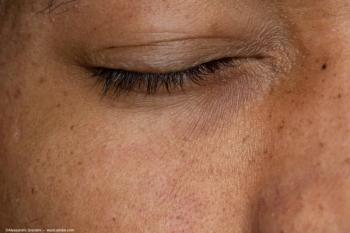
- Ophthalmology Times: November 1, 2020
- Volume 45
- Issue 18
Novel vehicle contributes to cyclosporine efficacy
Study shows improvements in signs, symptoms after 3 months of treatment
Special to Ophthalmology Times®
Topical cyclosporine A (CsA) has long been a mainstay of treatment for dry eye disease. In fact, for many years, CsA 0.05% (Restasis, Allergan) was the only treatment available to our patients, other than steroids or palliative artificial lubricants.
More recently, we have seen the introduction of lifitegrast 5% (Xiidra, Novartis), multiple treatments for underlying meibomian gland dysfunction, and higher-concentration CsA formulations (Cequa, Sun Pharmaceutical Industries; and Klarity-C, ImprimisRx) for a more robust armamentarium of treatment options for
Related:
CsA is an immunosuppressant that inhibits T-cell–mediated inflammation and cytokines, stimulates tear production, and increases goblet cell density.1,2
Despite its success in the marketplace and in many of our practices, there are still challenges with its use, including the high cost of the prescription solution for patients and burning or stinging on instillation, which can discourage patients from continuing the drops long enough to see an effect.
Additionally, it is challenging to formulate a topical CsA preparation because this molecule is not very water soluble.
I have been involved in a study to evaluate efficacy in a real-world clinical practice setting of a higher-dose (0.1%) cyclosporine (Klarity-C) in a unique chondroitin sulfate formulation.3
Chondroitin sulfate, a compound developed decades ago by Richard Lindstrom, MD, Herbert Kaufman, MD, and others, is the key ingredient in OptiSol-GS (Bausch + Lomb) and is used in several viscoelastic products. It has some unique properties of its own, including lubricating, anti-inflammatory, cell membrane stabilizing, and corneal edema reducing.4
Related:
Klarity-C, the drug used in our study, is a preservative-free drop compounded in a 503B FDA-regulated outsourcing facility. 503B pharmacies have to follow stringent quality and manufacturing requirements and are subject to the same FDA inspection and oversight as large pharmaceutical companies.
However, compounded medications are typically more affordable than other branded drugs.
Study design and results
This was a retrospective, multicenter study conducted by me, Jennifer Loh, MD, and William Trattler, MD.
Adult patients with a
Fifty-one patients with
The OSDI questionnaire measures
At 3 months, our patients’ mean OSDI score improved from 37.57 to 23.83 (P < .001). Pretreatment, 61% of the patients had OSDI scores in the “severe” range (33-100).
Related:
By 3 months, patients scoring in the severe range declined to 20%, and more than one-third of patients reported improvements in symptoms that put them in the normal (0-12) range.
Fluorescein staining of the entire cornea was evaluated for each eye (N = 102). The mean staining grade improved from 3.57 pretreatment to 2.17 (P < .001) at 3 months.
I find corneal staining with vital dyes to be an excellent diagnostic tool. In the PHACO study, Trattler et al showed that staining is extremely common in older patients, with 77% of those presenting for
One patient I treated in this study was a 71-year-old man who complained of blur, light sensitivity, and irritation, which he described as a “sandy, gritty feeling.”
He thought he needed stronger glasses because he had a hard time focusing to read. He was not on any ocular medications, including artificial tears. His medical history was significant for hypertension, controlled on lisinopril 10 mg and metoprolol 25 mg. He went through a full
Tear osmolarity (TearLab) was normal (300 oculus sinister and 301 oculus dexter), but an MMP9 test (InflammaDry, Quidel) was positive for the inflammatory marker in the tear film.He had 1+ central and inferior staining in both eyes, and his OSDI score was 22.7, putting him in the mild-to-moderate category.
Related:
I also like to look at topography images in evaluating dry eye. Pretreatment, the axial maps on the OPD-Scan III (Nidek Inc) revealed that this patient had tear film instability. We could also see missing and warped squares on the Cassini ocular surface qualifier, supporting the finding of an unstable tear film.
After 3 months of treatment with Klarity-C, this patient’s tear film was still not perfect, but the topography images were better; his OSDI score had improved from 22.7 to 6.25—well into the normal category—and he now had only trace inferior staining, with no staining centrally.
His symptoms improved, including the visual fluctuations that made him feel like something was wrong with his vision. He had no problems tolerating the drops.
CsA is a time-tested, effective treatment for inflammation in dry eye. Twice daily instillation of Klarity-C results in statistically significant improvement in OSDI scores and improvement in corneal staining while offering patients a favorable tolerability and cost profile.
About the author
Cynthia Matossian, MD, FACS, ABES
e:[email protected]
Matossian is the founder and medical director of Matossian Eye Associates, an integrated ophthalmology and optometry group practice with 3 offices in Pennsylvania and New Jersey.Matossian Eye is an affiliate of Prism Vision Group. She also serves as a clinical instructor in the Department of Ophthalmology at Temple University Lewis Katz School of Medicine. Matossian is a consultant to Allergan, Bausch + Lomb, ImprimisRx, Shire/Novartis, and Sun Pharmaceuticals.
---
References
1. Sall K, Stevenson OD, Mundorf TK, Reis BL. Two multicenter, randomized studies of the efficacy and safety of cyclosporine ophthalmic emulsion in moderate to severe dry eye disease. CsA Phase 3 Study Group. Ophthalmology. 2000;107(4):631-639. doi:10.1016/s0161-6420(99)00176-1
2. Kunert KS, Tisdale AS, Gipson IK. Goblet cell numbers and epithelial proliferation in the conjunctiva of patients with dry eye syndrome treated with cyclosporine. Arch Ophthalmol. 2002;120(3):330-337. doi:10.1001/archopht.120.3.330
3. Matossian C, Loh J, Trattler WB. Efficacy of topical 0.1% cyclosporine in chondroitin sulfate ophthalmic emulsion in patients with dry eye. Paper presented at: 2020 American Society of Cataract and Refractive Surgery Virtual Annual Meeting; May 16-17, 2020.
4. Lindstrom RL, Kaufman HE, Skelnik DL, et al. Optisol corneal storage medium. Am J Ophthalmol. 1992;114(3):345-356. doi:10.1016/s0002-9394(14)71803-3
5. Trattler WB, Majmudar PA, Donnenfeld ED, McDonald MB, Stonecipher KG, Goldberg DF. The prospective health assessment of cataract patients’ ocular surface (PHACO) study: the effect of dry eye. Clin Ophthalmol. 2017:11;1423-1430. doi:10.2147/OPTH.S120159
Articles in this issue
almost 5 years ago
Investigators study home-based monitoring for exudative AMDalmost 5 years ago
Ocular gene therapy offers hope for inherited retinal diseasealmost 5 years ago
Good nutrition optimizes ocular surface in premium cataract patientsalmost 5 years ago
Extended depth-of-field IOLs: Clarifying current nomenclaturealmost 5 years ago
Investigators show long-term visual declines in DME eyesalmost 5 years ago
Developing retinal technologies strengthen visualizationalmost 5 years ago
Building a brand is key to developing successful practiceabout 5 years ago
Changing patient conversations around cataract surgeryNewsletter
Don’t miss out—get Ophthalmology Times updates on the latest clinical advancements and expert interviews, straight to your inbox.
















































.png)


